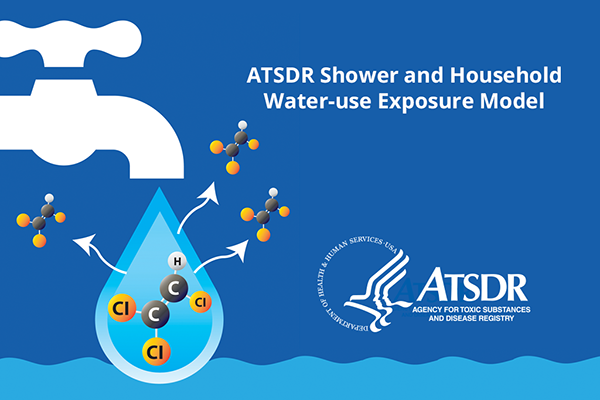Estimating Site-Specific Inhalation Exposures
This section describes how health assessors can estimate inhalation exposures. For training purposes, examples using fictitious site and exposure information are included.
Inhalation is an important pathway for human exposure to contaminants that exist as atmospheric gases or are adsorbed to airborne particles or fibers. Inhalation exposure to contaminants from hazardous waste sites can occur from:
- Direct releases of gases and particles from an on-site source (e.g., permitted point source, fugitive emissions).
- Volatilization of gases that migrate from contaminated soils or water bodies into the indoor air of overlying structures (known as vapor intrusion; see the resources in the box below).
- Resuspension of dust and particles from contaminated soil surfaces.
Note: Some contaminants, after being inhaled, can be absorbed by the respiratory epithelium and transported throughout the body by systemic blood circulation. Respiratory absorption is influenced by the contaminant concentration in the air, breathing rate, and duration of exposure.
Dermal exposure to some air contaminants could result in absorption through the skin. While it is unlikely that data will be available to quantitatively estimate exposures from this pathway, acknowledge this potential exposure pathway for air contaminants that can be readily absorbed through the skin.
Standard Approach for Evaluating Inhalation Exposures
ATSDR’s standard approach for evaluating inhalation exposures is to adjust the air concentration (EPC) by an appropriate EF (rather than calculate an exposure dose) depending on chronic, intermediate, or acute exposure. Health assessors can use PHAST (see PHAST text box below) to help evaluate inhalation exposures.
What inhalation scenarios should I run in PHAST’s Exposure Calculator?
PHAST has default and site-specific scenarios for air inhalation, including residential, daycare, school, occupational, and visitor.
The equation to calculate an adjusted EPC by the EF is shown in the box below.
AAC = (C × EF)
AAC = EF-adjusted Air Concentration (µg/m3), C = Contaminant Concentration (µg/m3), EF = Exposure Factor (unitless)
The purpose of this calculation is to adjust the air concentration to account for the duration, frequency, and time of exposure. The adjustment enables comparisons to duration-related inhalation non-cancer health guidelines and inhalation cancer risks.
The standard EF is calculated using this formula:
Exposure Factor (EF) = (F*ED)/AT
Where:
F = Exposure frequency
ED = Exposure duration
AT = Averaging time
If the target population has acute inhalation exposure to ammonia, hydrogen sulfide, chloroform, sulfur dioxide, or formaldehyde, do not adjust the EPC to a continuous 24-hr concentration because the acute inhalation Minimal Risk Level (MRL) for non-cancer effects was derived using the unadjusted study concentration. The same is true for intermediate and chronic exposure for chloroform and formaldehyde, which have MRLs based on the unadjusted study concentration, so the non-cancer EF should be 1.
To calculate an appropriate EF to use in this adjustment, health assessors need to understand the activity patterns of the exposed population. Use site-specific data if available, or the default activity pattern data from the EPA’s EFH Chapter 16 to help make appropriate determinations on indoor and outdoor activities where exposures could occur and the time spent at different places during the day (e.g., home, work, school). Default assumptions for various inhalation exposure scenarios are included in ATSDR’s Inhalation EDG. Also refer to default CTE and RME values in the EF equation in ATSDR’s Life Expectancy and Exposure Factor EDG.
In rare instances, health assessors need to evaluate increased breathing rates. In general, this need occurs when there is an identified population that performs intense physical exertion, such as at an exercise facility where an exposed population has higher than normal rates. For these types of site-specific scenarios, calculate the EF using the following formula and breathing rates outlined in ATSDR’s Inhalation EDG.
EF = (Elevated Breathing Rate/Default Breathing Rate) * ((F*ED)/AT)

For releases of volatile and semi-volatile contaminants during indoor water use, health assessors will use ATSDR’s SHOWER Model to calculate the contaminant concentration in air in various parts of the house. These data, in combination with time-activity profiles of residents, can be used to estimate indoor air exposures to vapor-forming contaminants (discussed below). Any exposures from indoor water use could increase if vapor intrusion is also a pathway of concern.
This example uses the EF-adjusted air concentration formula shown previously in this section to calculate an EF-adjusted air concentration.

Use this tool when evaluating inhalation to indoor air concentrations of volatile and semi-volatile contaminants from household water use for showering, tub bathing, clothes washing, and other activities. Anyone can request a copy of the SHOWER Model by emailing showermodel@cdc.gov.
Scenario: A substitute science teacher worked at ABC Elementary School for 5 days/week for 30 weeks during a school year. Based on air sampling in the teacher’s classroom, an EPC for formaldehyde was calculated to be 30 µg/m3.
The EF for this intermediate exposure duration is calculated as follows:
EF = (F x ED) / AT
EF = (5 days x 30 weeks) / (7 days x 30 weeks)
EF = 0.71
Next, calculate the EF-adjusted concentration as follows:
EF-adjusted air concentration = EPC x EF
EF-adjusted air concentration = 30 µg/m3 x 0.71
EF-adjusted air concentration = 21.3 µg/m3
ATSDR only calculates inhalation exposure doses for very particular site-specific scenarios. When calculating these exposures in indoor air, remember that actual exposures depend on factors such as contaminant emission rates from indoor sources, background air concentrations of the contaminant, and the rate of air exchange between the building and the outdoors. Health assessors can use ATSDR’s SHOWER Model (see box to the right) when evaluating inhalation exposures to indoor air concentrations of volatile, semi-volatile, and other contaminants in household water. The SHOWER Model simulates contaminant releases from common household water uses such as showering, tub bathing, and clothes washing to generate average daily air exposure concentrations for each person in the house. To evaluate inhalation exposures, you can use the EPC household water concentration (generated outside of the SHOWER Model, refer to the EPCs section for more details) to develop an 1) average daily air exposure concentration, 2) inhalation dose for the inhalation pathway, and 3) acute high exposure concentration. The default scenario in the SHOWER Model requires only the contaminant name and the EPC water concentration as inputs. Users also have the option of simulating a custom scenario when additional site-specific information is available.

See how the SHOWER Model fits into the entire PHA process in this diagram (under development). Also refer to instructions for using the model [PDF – 3 MB] and the SHOWER Model Guidance (under development). Anyone can request a copy by emailing showermodel@cdc.gov.
For a subset of special-case contaminants, health assessors can calculate a combined total dose via the ingestion, inhalation, and dermal uptake exposure routes. For this combination to be appropriate, the chemical must have the same toxic endpoints via the oral and inhalation routes. If, and only if, these conditions are met, health assessors can combine the inhalation dose with the oral and dermal doses to get a total dose from all three routes of exposure. You would do this summation by combining the inhalation exposure doses and dermal exposure doses (explained in the Drinking Water section) generated by the SHOWER Model with the oral exposure doses for drinking water generated via PHAST.